When the Chinese Culture Club in Beijing offered a tour of a famous TCM hospital in the heart of Beijing, we couldn't resist! The CCC tour promised us an up-close-and-personal experience with acupuncture, "cupping", and pulse-diagnosis. All of us were intrigued, especially since so many of our Chinese friends - along with some Westerners - swear by TCM, so why not check it out?
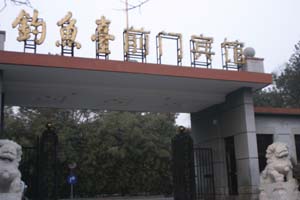 |
The center is located right on the edge of Tiananmen Square, in a compound that is normally off-limits to foreigners, since it includes the home of Beijing's mayor. Gracie Mansion it's not, but the compound does have an interesting history. |
It was the personal office for Premier Zhou En Lai, who protected it from destruction during the Cultural Revolution. Later on, it served as the first official American presence in China - a "pre-embassy" where George Bush One and Barbara lived after Nixon visited and before US-China formal relations were re-established in 1979.
Unfortunately, we weren't able to enter any of the residential buildings that day, since they were being used for a TV soap opera shoot! (Welcome to New China). So after trying to peek in windows and being shooed away, we followed our CCC guide to the TCM center on the courtyard's southwest side.
At first glance, the doorway did not inspire much confidence. The name plate was polished, but the building istself was falling apart. The doorway was covered by a thick canvas blanket in an attempt to keep the chilly Beijing air at bay. Despite its run-down exterior, however, almost every one of our Chinese friends knows about this place. Its fame stems from the fact that it's been the medical provider for China's top leaders since 1949. |
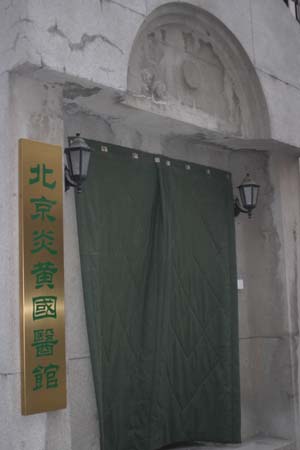 |
Once inside, we were greeted by a staff of helpful nurses, each dressed in a uniform straight from the 1950s. The whole place felt as if we had stepped back in time -- from the white, starched uniforms to the Communist slogans on the walls, to the drab overstuffed furniture. It was easy to see how old Party members would find the place relaxing -- it was a time warp back to their heyday! |
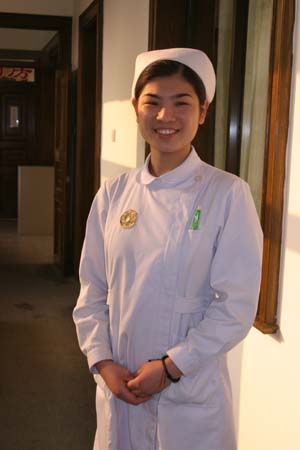 |
Because it was a working medical center (depsite feeling somewhat like a musuem), the tools of the trade were everywhere.
The first thing that caught our eye was a half-sized statue of a man, indicating each acupuncture points. The girls were of course fascinated, especially by the lower half of the front side. I (this is Tom writing) decided to not post it here, both to avoid any censors, and since it makes me wince and shiver in all sorts of uncomfortable places every time I look at it!
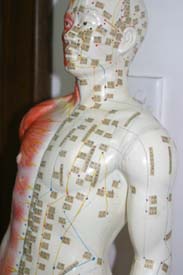 |
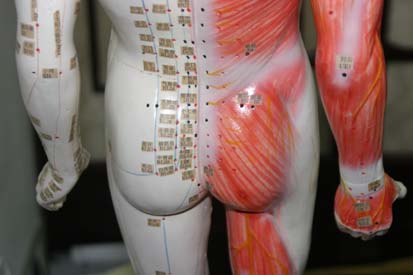 |
As promised, we each had the opportunity to undergo the regimens practiced at the center.
The first stop was pulse-diagnosis, shown below. A practioner uses her fingers to listen carefully to your pulse, from two different locations on your left wrist. She also asks a few questions, such as your age and weight. Finally, she takes a quick glance at your tongue - using no depressor - you just stick it out! She then delivers a diagnosis, and proceeds to apply pressure on certain points that need it.
 |
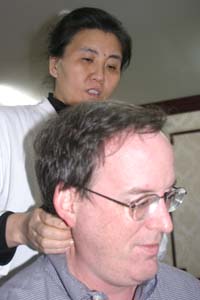 |
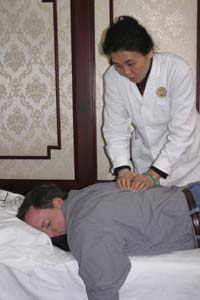 |
My diagnosis was: stomach and left side were a little "hot," but everything else was fine. The pressure point stuff felt good, but it didn't feel like much changed.
To be honest, I was sketpical going in, and even more so after experiencing pulse-diagonsis for myself. Give me an EKG any day!
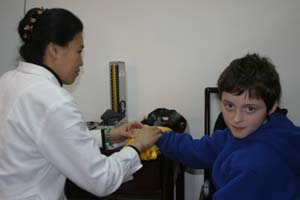 |
My skepticism evaporated, however, when it was Sami's turn. The doctor went through the same steps, but took a bit more time to double check. Then she asked if Sami experienced a very specific chronic condition, which in fact, she does! (the details of which are withheld to protect Sami's privacy). |
We were all amazed. It was hard to believe that this condition, which has nothing to do with blood, blood pressure, or her tongue, could be diagnosed through this method! Hm. Maybe there IS something to TCM after all.
Next stop: cupping! I had heard about cupping, formally known as "moxibustion," and seen the service listed in spas we had visited, but I didn't really know what it was. We were first in line, so we didn't have the luxury of seeing someone else undergo the procedure. Since the girls dared me to step forward, I had no choice.
The little room had an examining table and a simple tray with a bunch of strange glass shapes. They looked like upside-down bowls, or tops for some strange kind of bottle.
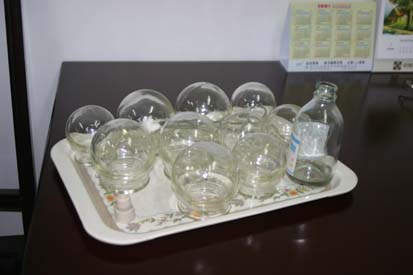 |
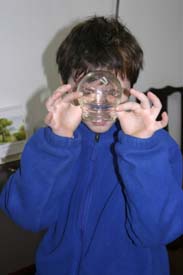 |
I had no idea what to expect, so when they told me to pull up my shirt and lay face down on the table, I complied. Fortunately, I wasn't able to see what they were doing, and only saw the following photos after the fact. I'm not sure I would have been as "brave" had I known what I was getting into!
Step one is to take each glass, light a wick made of fibers from the mugwort plant, use the flame to create a vacuum inside the glass, and then rapidly place the glass mouth-down on top of the patient's back. The heat of the wick has sucked out the oxygen, so it creates a suction effect on the skin. I had no idea what they were doing - literally behind my back! Every so often I heard the flick of a lighter, and then felt a round glass thing being placed gently on my back. It wasn't hot, and it didn't hurt (neither when it was placed, nor afterwards).
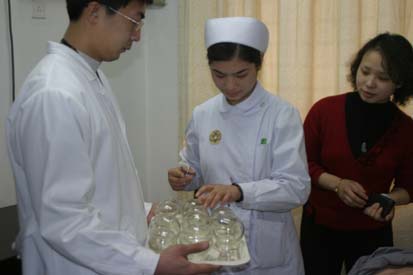 |
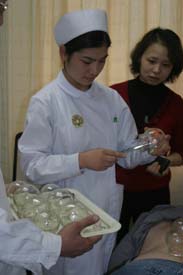 |
As the pictures below show, my back was quickly covered with the whole set of cups, placed in some type of pattern and sequence. I assume that the pattern and sequence is standard, but I wasn't in any position to ask questions at the time!
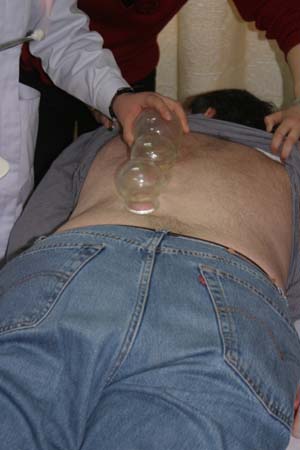 |
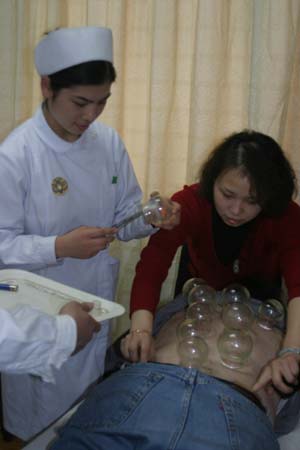 |
At last they were done -- a total of ten glass cups were suctioned onto my back. By that point, I was dozing, despite being surrounded by the medical staff, the two kids, Sharon and her camera, and other people on the tour. I remember feeling strangely relaxed, like the feeling at the end of a good massage.
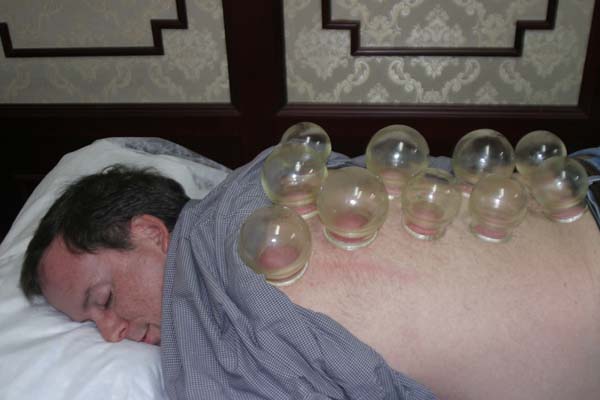
As you can see, the vacuum inside the glass objects was causing my skin to turn red and puff up. I didn't feel any of this at the time, and had no idea it was going on. I remember hearing people gasp, but I figured it was due to something else, not me!
After about ten minutes, the staff started to take the cups off. They came off easily, with no popping sound or tugging sensation. As the pictures below show, the skin inside the glass had puffed up and turned red, though in varying degrees. It was soft to the touch, and kind of spongy.
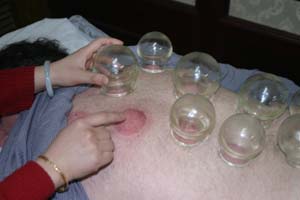 |
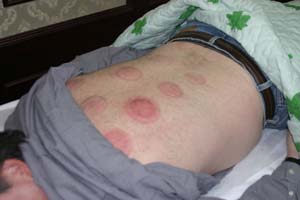 |
What was interesting is that the result of this treatment matched what the pulse-diagnostician had said -- I was "hot" on my left side. I still don't know what that really means, but it's quite interesting that even though all of the cups were lit and positioned in the same way, the resulting red spots were quite different!
Of course, at the time (having not seen these pictures), I didn't realize what my back looked ike. But I felt great -- as if I had woken up from a long nap after a deep massage. In fact, I had only dozed lightly for about 10 minutes, and no one had given me a rubdown.
After I got dressed, we decided to skip the acupuncture, both because there was a long line, and because the woman we saw undergoing the treatment was actively wincing in pain each time a needle was inserted. I thought that acupuncture was painless!
As it turned out, one of the experts said that that wasn't always true. Sometimes acupuncture does hurt, depending on what is being treated, and where the needles are inserted. It didn't help to see the doctor's worktable, which was covered with pieces of blood-stained gauze. Even I have limits as to what I'll let the girls dare me to do!
Instead, we scooted down the hall to the pharmacy, which was fascinating (and very fagrant, since the many drawers were packed with bark, herbs and...other stuff). There, a white-coated "pharmacist of traditional medicine" gave a talk about how traditional Chinese medicine works.
The centerpiece of any Chinese pharmacy is the medicine cabient -- usually a gargantuan set of little wooden drawers. Before opening the drawers, the pharmacist writes up a perscription, which is always fine-tuned for the individual patient. It looks like a recipe, and specifies the exact types and amounts of each ingredient.
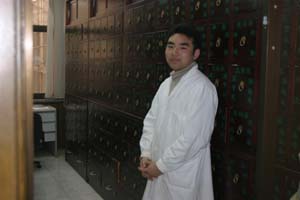 |
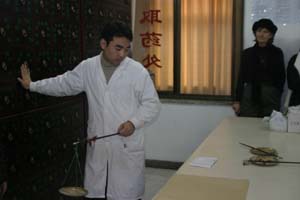 |
Referring to the perscription-recipe, the pharmacist opens a drawer, weighs out a certain ingredient, and places it on a piece of paper. The scale was fascinating, since even though it looks quite primitive, it's supposedly accurate to the gram!
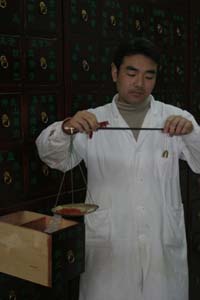 |
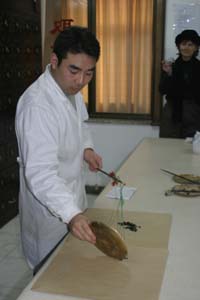 |
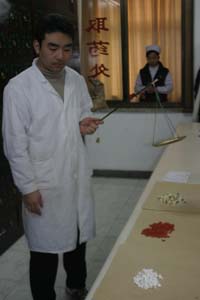 |
As the pharmascist did this, he gave a detailed explanation about the origin of each ingredient. Most were medicinal plants from a special organic farm outside Beijing, which was guarded around the clock and used exclusively by this clinic. I guess the government doesn't want their leaders to ingest the wrong stuff!
The girls were understandbly a bit bored by the lecture, until the pharmacist encouraged us to start smelling and tasting the ingredients! It felt weird tasting the raw ingredients of medicine, but we were assured it was safe. Most of them had strange flavors, though some were a welcome surprise: cinnamon, dried fruits, and vanilla were some of our favorites.
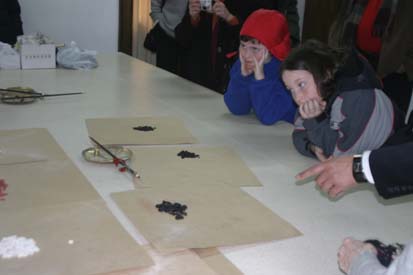 |
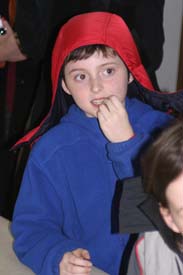 |
While the pharmacist continued to explain, I sneaked a peak inside some of the drawers near me. One was filled with dried scorpions! (we didn't sample those). Another had all sorts of dried mushrooms. Meanwhile, someone asked what the most expensive and exotic ingredient was that the pharmacy had in stock.
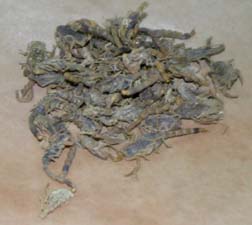 |
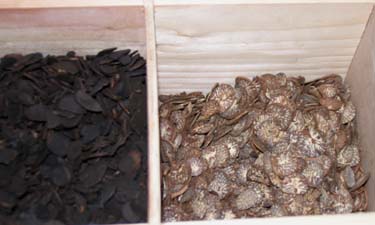 |
The answer was a kind of flying lizard that only lives in certain caves and is hard to catch. Once captured, the lizards need to be dried and cured, and then shipped over great distances to Beijing.
I couldn't resist!
After all, they looked SOO yummy!
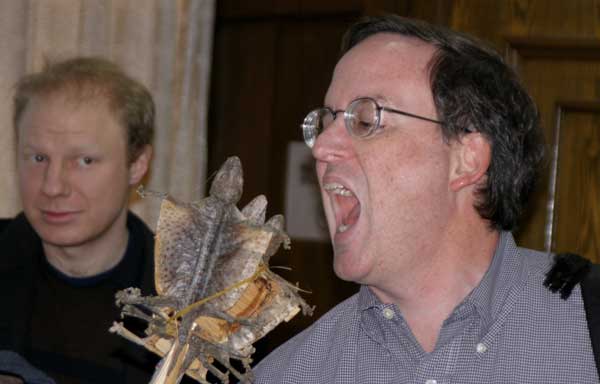
The guy in the background was dubious about their medicinal value, but after taking a big bite, I can tell you that they tasted, well, like chicken...
And I'm still alive to write about it!